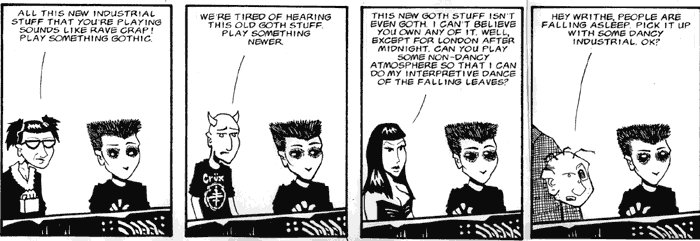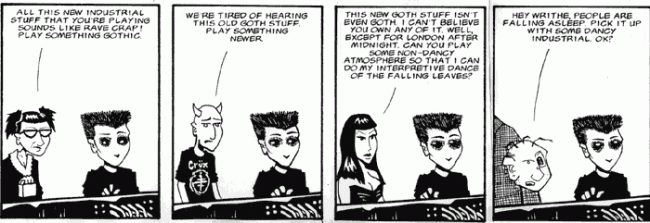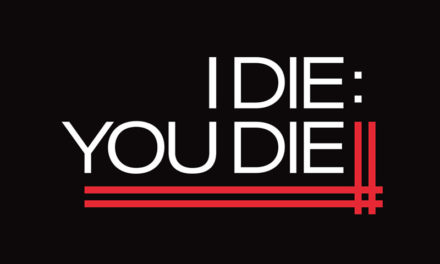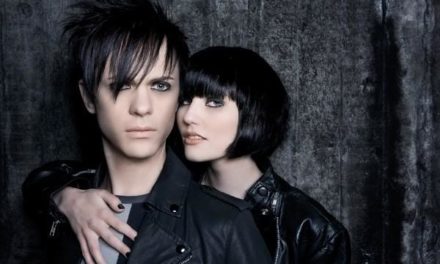Carrying on from what Alex wrote, one of the few commonalities that seems to tie Our Thing together is that whatever it is, its most hardened devotees agree: it sucks now. Perhaps that’s not so surprising, just about every subculture likes to hearken back to some Golden Age when “things were real”, but the multiplicity of sounds and histories which fall under the rubric of “dark alternative” stuff gives everyone and their axe to grind an easy out. Rather than simply yearning for nostalgia, anyone can point to entire sub-genres and declare them crap, the weigh of which is dragging the scene as a whole into mediocrity. We’ve all heard arguments like this before: EBM isn’t “real industrial” (and futurepop doubly so), you can’t dance to powernoise, nobody listens to goth rock anymore, etc.
To some extent, problems like this are endemic to any big-tent scene. But in the short-term, what about the music itself, evaluated by the standards of its own particular sub-sub-sub-genres? I’ve been guilty of giving damning State of the Unions in the past, of bemoaning the lack of interesting releases on once fresh and vital labels. Obviously, if you give a rat’s ass about music of any stripe you have to get active about looking for good new stuff, but even while putting in work I’ve been tempted now and again to throw in the towel and resign myself to a retirement made up of naught but soul and metal records.
That hasn’t been the case recently. Over the past year and a bit I’ve been overwhelmed by a barrage of new releases (and some reissues) from across the spectrum which have reminded me why I was drawn to the likes of, say, 242, the Sisters and Haujobb in the past, as well as some which have tantalizingly hinted at the shape of things to come. So, in the spirit of starting this, mine and Alex’s third foray into music blogging, on the right foot forward, here are ten reasons (all soon to be topics of separate posts) to be cheerful (to cop a phrase from Greg Egan) about the future of This Thing Of Ours:
Necro Facility
The Skinny Puppy-isms of their first two albums have given way to some of the strongest and most accessible club material of recent years. Catchy and well-produced, their 2011 album Wintermute is an early contender for favourite of the year.
Pretentious, Moi?
A trad-goth supergroup of sorts whose work has been percolating for years, their debut album recalls why we fell in love with just about every band Uncle Mick recommended to us in our teens. Leeds (or a corking representation thereof) stand up.
Liquid Divine
Another group that’s been around for a bit but with their 2009 album Autophobia coalesced into something fully formed. Recalling mid-period Haujobb and the smart polish of mind.in.a.box, it’s an album with poise and refinement, a real treat in a sea of clumsy aggression.
Absolute Body Control
A project that has existed since the early 80s, their 2010 release Shattered Illusion is simultaneously indistinguishable from their initial work yet still sounds utterly contemporary. The tension between singer (and scene godfather) Dirk Ivens and the buzzing electronics that make up their sound is compelling and radically atmospheric.
Kant Kino
While they’d never be accused of reinventing the wheel, this recent project is somehow far more satisfying than almost any other harsh electro act in recent memory. They’ve struck upon a great balance of melody and crunch, and their debut LP’s rife with club fodder.
//TENSE//
Although more associated with the recent gravewave phenomenon, //TENSE// are mining the rich vein of classic EBM originally pioneered by Cabaret Voltaire and Front 242. It’s refreshing to see something gaining buzz and credence outside of the ghetto of the dark electronic club scene which is so steeped in it.
Haujobb
Roaring back almost a decade after the release of their last record of original material, the release of 2011’s Dead Market single marked the return of thinking-person’s EBM. Myer and Samardzic have always occupied a special place in the industrial world, and their time working on side and solo projects hasn’t reduced any of their mojo.
Continues
Dan Gatto’s reputation as a consumate performer with Babyland crosses scenes and decades, and he’s going straight for the sweet synth-pop throat with his new work as Continues. A stand out performance at this year’s Kinetik festival and a few tantalizing samples of what he has in store for his debut have us salivating for what’s to come.
Access to Arasaka
The hype says that AtoA are the successors to Gridlock’s vacant crown, but don’t do them the disservice of thinking them a tribute act. This is some thoughtful and complex IDM; in the late 90s we called it technoid, the project is standing right where the lines between abstract techno and new school ambience blur into glorious sound.
Kirlian Camera
The perennial darkwave standard bearers are still active and still producing some of the most magisterial and breathtaking music we’ve collectively ever heard. With a full-length on deck and the recent Ghlóir Ar An Oiche EP folks should stay mindful, KC are still building on their already considerable legacy.





I think one of the biggest drawbacks to electronic music in general is that it’s a lot easier to make now than it was 10, 20, or 30 years ago. Back in the 80s even making stuff that seems laughably simple now, like old Nitzer Ebb or Absolute Body Control tracks (which are really just vocals, a couple arpeggios, and a drum machine) was tedious work because everything was analog, if you could even afford to record it in the first place. In the 90s things were a little more accessible with the advent of digital recording, but it was still expensive as hell and PCs were sluggish and crashed often.
Now, any kid with a couple grand to burn can go out and buy the digital equivalent of what would have been a $100,000 recording studio 25 years ago. The problem with this is that while there is some good stuff coming out, there’s also a lot of stuff coming out that simply put is just garbage and wouldn’t have even been made before. Back when things were expensive and tedious, it was a passion. Now, it’s a hobby. There’s a lot of crap to wade through to find the gems now.
One could make the argument that there has always been bad music to wade through, but the volume of it now surpasses anything before, especially as electronic music continues to gain popularity.
Salient points. I recently found out that Atari Teenage Riot used an old ST with 2 megs of RAM to sequence their most recent album because it was an essential part of their “sound”. I’m guessing they aren’t alone, although whether they take the route of older gear or a totally digital environment I like to think that artists who put in work will stand out, at least to the discerning ear.